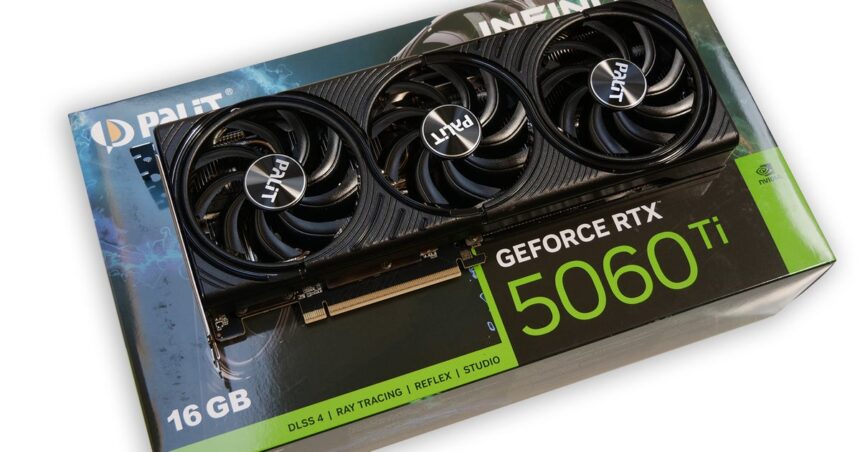The RTX 5060 Ti is here, and with it, the first ostensibly “mainstream” graphics card from Nvidia’s 50-series Blackwell architecture – though with MSRPs at $379/£349 for the 8GB card and $429/£399 for the otherwise identical 16GB variant, there’s still an appreciable gap over the entry-level RTX 5060 at $299.
Having both 8GB and 16GB models available muddies the waters somewhat, so let’s make things simpler: don’t consider buying the 8GB model. Reporting from Digital Foundry and the tech press at large has made it increasingly clear that 8GB isn’t sufficient for anything other than the most entry-level cards, so in a world where you’ll likely be keeping your GPU for three to five years, it’s best to make alternative arrangements. The fact that Nvidia isn’t sending out samples of the 8GB card speaks for itself, really.
With the 16GB card in hand then, we’d ideally like to see a card that offers a touch more value than the RTX 5070, while at the same time delivering a palpable boost over the lacklustre RTX 4060 Ti – which also came in two guises: a disappointing 8GB model and a vastly overpriced 16GB alternative. This time around, the 8GB version is cheaper, while the price premium for the 16GB version is much reduced. It’s a welcome move.
Let’s look at specs. With 4608 CUDA cores, we’re only seeing a six percent increase over the RTX 4060 Ti, with the 5070 delivering a 33 per cent increase – albeit with slightly slower boost clocks. The 5060 Ti does has a huge memory bandwidth advantage over its predecessor, to the tune of 55.5 percent, but again, the 5070 is far ahead – a straight 50 percent increase. So in theory then, the 5060 Ti shouldn’t trouble the 5070 at all. However, in terms of gen-on-gen increases, we should see some impressive results – depending on how much the Blackwell architecture taps into that bandwidth – and of course the extra 20W ceiling on total board power.
And with that out of the way, a quick word on the card reviewed today. It looks like there isn’t a Founders Edition card for the 16GB 5060 Ti, so Nvidia has sampled us with the Palit Infinity 3 version and I can’t say I have any issues with it at all. Bearing in mind that the 5060 Ti typically draws between 150 to 170W of power during play, the relatively massive heatsink and tri-fan design is perhaps overkill for this class of performance, but the bottom line is that it’s very very quiet indeed – my CPU cooler makes more noise. It’s a dual-slot design too, so it ought to be a good choice for SFF builds that can accept its 292mm length.
As expected, just one PCIe eight-pin power input is needed, while external ports consist of the standard trio of DisplayPort 2.1 ports and the ubiquitous HDMI 2.1. While the card ships with a PCIe x16 slot, it’s clearly x8 only, so a PCIe 4.0 board or better is recommended for this one.
| RTX 5070 Ti | RTX 5070 | RTX 5060 Ti | RTX 5060 | |
|---|---|---|---|---|
| Processor | GB203 | GB205 | GB206 | GB206 |
| Cores | 8,960 | 6,144 | 4,608 | 3,840 |
| Boost Clock | 2.45GHz | 2.51GHz | 2.57GHz | 2.50GHz |
| Memory | 16GB GDDR7 | 12GB GDDR7 | 16GB GDDR7 8GB GDDR7 |
8GB GDDR7 |
| Memory Bus Width | 256-bit | 192-bit | 128-bit | 128-bit |
| Memory Bandwidth | 896GB/s | 672GB/s | 448GB/s | 448GB/s |
| Total Graphics Power | 300W | 250W | 180W | 150W |
| PSU Recommendation | 750W | 650W | 450W | 450W |
| Price | $749/£729 | $549/£539 | $429/£399 $379/£349 |
$299 |
| Release Date | February 20th | March 5th | April 16th | May |
Before we get into our benchmarking proper, it’s interesting to get a quick sense of power efficiency – and this looks to be one of the card’s strong suits. In Black Myth: Wukong, for example, the 5060 Ti delivers 95 percent of the 4070’s performance while consuming 81 percent of the power. Overclocking takes us north of 3GHz, with frame-rates that beat the 4070 while still only using 85 percent of the power. The RTX 5070, meanwhile, is 35 percent faster but requires 44 percent more power, making the 5060 Ti the most efficient card from this lineup of three.
We see a similar story in Forza Horizon 5, another rasterised test, with impressive efficiency numbers when overclocked or stock, but RT performance is where the 5060 Ti falls down slightly. In Hitman: World of Assassination, for example, the 4070 is 16 percent faster than the stock 5060 Ti and five percent faster than the overclocked card. That lets the 4070 draw level with the 5060 Ti in efficiency terms, while the 5070 is a further 35 percent ahead of the 5060 Ti while consuming 45 percent more power.
I’d say efficiency overall is very good against the 5070, but more impressive comparatively when RT is not in play. Overclocking seems worth exploring too, with a +350 core and +500 memory overclock ramping up power demands negligibly – while delivering around 7.6 percent extra performance.
Of course, we’ll be using stock clocks for the bulk of our performance testing. To put the onus on the graphics card, we’re using a top-end system for our benchmarks, based around the fastest gaming CPU – the AMD Ryzen 7 9800X3D. We also have 32GB of Corsair DDR5-6000 CL30 memory, a high-end Asus ROG Crosshair X870E Hero motherboard and a 1000W Corsair PSU.
With all that said, let’s get into the benchmarks.
Nvidia GeForce RTX 5060 Ti 16GB Analysis
- Introduction, power efficiency and test rig [This Page]
- RT benchmarks: Alan Wake 2, Avatar: Frontiers of Pandora, Cyberpunk 2077
- RT benchmarks: Dying Light 2, F1 24, Hitman: World of Assassination
- RT benchmarks: Indiana Jones and the Great Circle, Metro Exodus Enhanced Edition, A Plague Tale: Requiem
- Game benchmarks: Alan Wake 2, Black Myth: Wukong, Cyberpunk 2077
- Game benchmarks: F1 24, Forza Horizon 5, Senua’s Saga: Hellblade 2
- Game benchmarks: Hitman: World of Assassination, A Plague Tale: Requiem
- PCIe 3.0 vs PCIe 5.0: Black Myth: Wukong, F1 24, Indiana Jones and the Great Circle
- Conclusions, value and recommendations
To see this content please enable targeting cookies.





